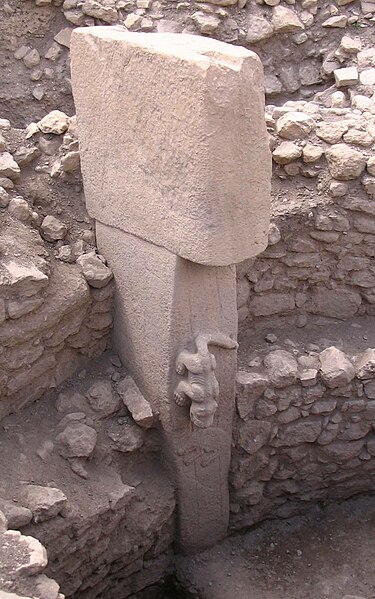
Charles C. Mann reports at National Geographic (June 2011):
We used to think agriculture gave rise to cities and later to writing, art, and religion. Now the world’s oldest temple suggests the urge to worship sparked civilization.
He is referring to Gobekli Tepe,
Before them are dozens of massive stone pillars arranged into a set of rings, one mashed up against the next. Known as Göbekli Tepe (pronounced Guh-behk-LEE TEH-peh), the site is vaguely reminiscent of Stonehenge, except that Göbekli Tepe was built much earlier and is made not from roughly hewn blocks but from cleanly carved limestone pillars splashed with bas-reliefs of animals—a cavalcade of gazelles, snakes, foxes, scorpions, and ferocious wild boars. The assemblage was built some 11,600 years ago, seven millennia before the Great Pyramid of Giza. It contains the oldest known temple. Indeed, Göbekli Tepe is the oldest known example of monumental architecture—the first structure human beings put together that was bigger and more complicated than a hut. When these pillars were erected, so far as we know, nothing of comparable scale existed in the world.
This site, older than Stonehenge, was constructed, archaeologists think, before writing, metal, pottery, or wheels, and – along with other recent finds – has changed the way archaeologists see prehistoric peoples.
Briefly, Mann says that the site has dealt a heavy blow to the reigning theory that sees agriculture as the organizing principle of prehistoric society, because the massive structures point so clearly to religion. The level of organization required is much greater than that required for village-level subsistence agriculture, and the consensus is that concern about a greater reality is the only plausible reason people fell led to bother. Incidentally, the site appears to have been purely ceremonial; no town grew up in its midst.
For the archaeologists,
Puzzle piled upon puzzle as the excavation continued. For reasons yet unknown, the rings at Göbekli Tepe seem to have regularly lost their power, or at least their charm. Every few decades people buried the pillars and put up new stones—a second, smaller ring, inside the first. Sometimes, later, they installed a third. Then the whole assemblage would be filled in with debris, and an entirely new circle created nearby. The site may have been built, filled in, and built again for centuries.
This does suggest a theory of some kind about the nature of things.
Bewilderingly, the people at Göbekli Tepe got steadily worse at temple building. The earliest rings are the biggest and most sophisticated, technically and artistically. As time went by, the pillars became smaller, simpler, and were mounted with less and less care. Finally the effort seems to have petered out altogether by 8200 B.C. Göbekli Tepe was all fall and no rise.
Lost their faith? Converted to another religion?
Take home point:
“Twenty years ago everyone believed civilization was driven by ecological forces,” Schmidt says. “I think what we are learning is that civilization is a product of the human mind.”
In short, we are learning what the wise always knew.
Some ask: Could this new thesis in archaeology be discussed in publicly funded American classrooms? Will classrooms be stuck with what archaeologists no longer believe, to skirt legal issues?